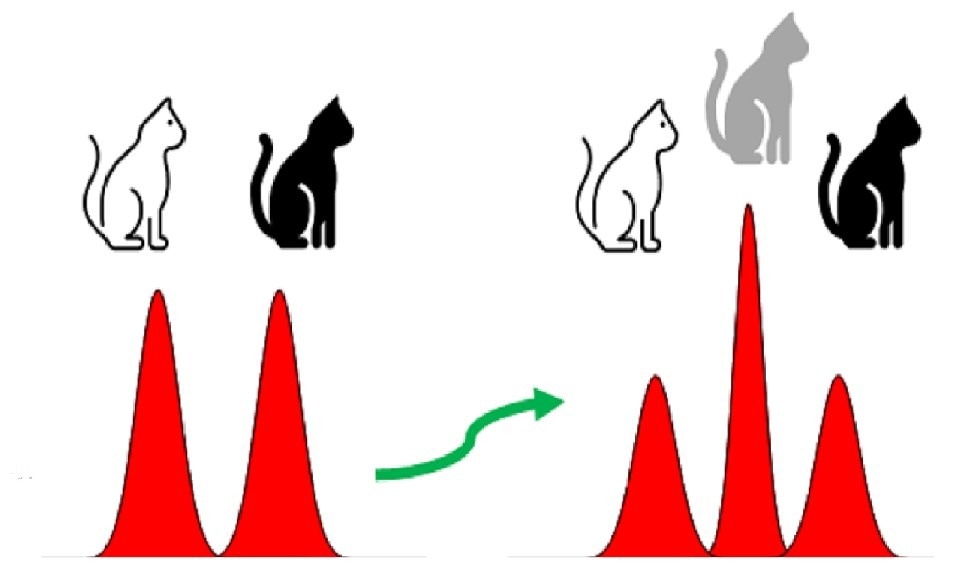Researchers from the universities of Mainz, Olomouc, and Tokyo have achieved the creation of a logical qubit from a single light pulse, endowed with the inherent capability to correct errors.

The creation of a photonic “Schrödinger cat state” – in other words, the quantum superposition of states of the laser pulse amplitude that can be distinguished on a macroscopic scale (white or black cat) – can only be achieved using the most advanced quantum optical techniques and has already been demonstrated to be possible. In the present experiment that is the subject of the research paper, it proved to be feasible to extend this to three states (white, gray, and black cats). This light state thus approaches a logical quantum state in which errors can be, in principle, universally corrected. Image Credit: Peter van Loock
Significant advancements have been made in the field of quantum computing. Large international companies like Google and IBM already provide cloud-based quantum computing services. Quantum bits, or qubits, are the fundamental units of quantum information, and their availability is still insufficient to solve all problems that arise when standard computers are unable to handle them. This is due, in part, to the fact that bare qubits are not immediately useful for executing quantum algorithms.
Qubits have the ability to represent both 0 and 1 simultaneously, introducing probability into the information they store, in contrast to conventional computers’ binary bits, which store information as fixed values of either 0 or 1.
This is called quantum superposition. They are, therefore, highly vulnerable to outside influences, which increases the likelihood that the data they store will be lost. To guarantee that quantum computers produce accurate results, multiple physical qubits must be joined together to form a logical qubit through the creation of a true entanglement. The information will not be lost if one of these physical qubits fails. Nonetheless, a primary obstacle impeding the advancement of operational quantum computing is the substantial quantity of physical qubits necessary.
Advantages of a Photon-Based Approach
A wide range of ideas are being used to enable practical quantum computing. For example, superconducting solid-state systems, which are currently used by large corporations, have the drawback of only working at temperatures very near absolute zero. Conversely, photonic concepts function at room temperature. Here, single photons are typically used as physical qubits.
Compared to solid-state qubits, these photons - which are essentially tiny particles of light - operate more quickly by nature, but they also lose energy more quickly. As with the superconductor-based method, it is vital to couple multiple single-photon light pulses together to create a logical qubit in order to prevent qubit losses and other errors.
A Qubit With the Inherent Capacity for Error Correction
Researchers from the University of Tokyo, Palacký University Olomouc in the Czech Republic, and Johannes Gutenberg University Mainz (JGU) in Germany have recently demonstrated a new method for building a photonic quantum computer. The group used a laser-generated light pulse, which can contain multiple photons instead of a single photon.
Our laser pulse was converted to a quantum optical state that gives us an inherent capacity to correct errors. Although the system consists only of a laser pulse and is thus very small, it can - in principle - eradicate errors immediately. Thus, there is no need to generate individual photons as qubits via numerous light pulses and then have them interact as logical qubits. We need just a single light pulse to obtain a robust logical qubit.
Peter van Loock, Professor, Mainz University
Stated differently, this system already possesses the ability to translate a physical qubit into a logical qubit, which is an amazing and novel idea. But as of yet, the University of Tokyo's experimentally produced logical qubit was not good enough to offer the required degree of error tolerance. However, the researchers have unequivocally shown that the most cutting-edge quantum optical techniques can be used to convert non-universally correctable qubits into correctable qubits.
The relevant research findings were published in Science. They are based on a 20-year collaboration between Peter van Loock's theoretical team in Germany and Akira Furusawa's experimental group in Japan.
Journal Reference
Konno, S., et al. (2024) Logical states for fault-tolerant quantum computation with propagating light. Science. doi.org/10.1126/science.adk7560.